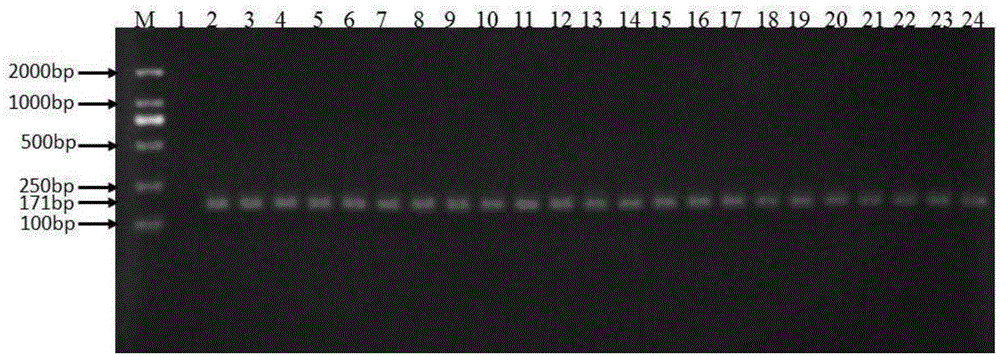Safflower DNA bar code standard gene sequence
A gene sequence and barcode technology, applied in the field of specific primer combination, can solve the problem of difficult to distinguish appearance, and shorten the identification time.
- Summary
- Abstract
- Description
- Claims
- Application Information
AI Technical Summary
Problems solved by technology
Method used
Image
Examples
Embodiment 1
[0044] Utilize HHF1651 / HHR1822 primer combination, wherein
[0045] HHF1651 as SEQ ID NO.2 in the sequence listing;
[0046] HHR1822 as SEQ ID NO.3 in the sequence listing;
[0047] Perform PCR amplification identification.
[0048] 1. Experimental materials
[0049] 1.1 Plant material
[0050] The different safflower varieties tested are shown in Table 1.
[0051] Table 1 The name and origin of safflower varieties
[0052]
[0053] The other 17 different species of materials are: sunflower (Helianthusannuus), soybean (Glycinemax), corn (Zeamays), cotton (Gossypiumhirsutum), tomato (Solanumlycopersicum), wheat (Triticum), barley (Hordeumvulgare), cowpea (Vignaunguiculata) , Carrot (Daucus carota), Rapeseed (Brassicanapus), Capsicum (Capsicumannuum), Peanut (Arachishypogaea), Sesame (Sesamumindicum), Radish (Raphanus sativus), Rice (Oryza sativa), Tobacco (Nicotianatabacum), Arabidopsisthaliana.
[0054] 1.2 Enzymes and Reagents
[0055] Molecular biology reagents, TA...
Embodiment 2
[0083] Utilize HHF1651 / HHR1822 primer combination, wherein
[0084] HHF1651 as SEQ ID NO.2 in the sequence listing;
[0085] HHR1822 as SEQ ID NO.3 in the sequence listing;
[0086] Perform PCR amplification identification.
[0087] 1. Experimental materials
[0088] 1.1 Plant material
[0089] Sunflower petals, safflower petals, cakes containing safflower ingredients, rapeseed cakes, safflower pollen, rapeseed pollen.
[0090] 1.2 Enzymes and Reagents
[0091] Molecular biology reagents, TAKARATaqDNA polymerase, 10×PCR buffer, dNTP Mixture (10mM), MgCl 2 purchased from Dalian Bao Biological Company. PCR primers were synthesized by Shanghai Sangon Bioengineering Technology Service Co., Ltd.
[0092] 1.3 Experimental Instruments
[0093] PCR amplification instrument: DNAEngineDyadPeltierThermalCycler (Bio-Rad, USA);
[0094] Nucleic acid electrophoresis instrument: DYYIII type YY0115-94 (Beijing Liuyi Instrument Factory);
PUM
 Login to View More
Login to View More Abstract
Description
Claims
Application Information
 Login to View More
Login to View More - R&D Engineer
- R&D Manager
- IP Professional
- Industry Leading Data Capabilities
- Powerful AI technology
- Patent DNA Extraction
Browse by: Latest US Patents, China's latest patents, Technical Efficacy Thesaurus, Application Domain, Technology Topic, Popular Technical Reports.
© 2024 PatSnap. All rights reserved.Legal|Privacy policy|Modern Slavery Act Transparency Statement|Sitemap|About US| Contact US: help@patsnap.com










